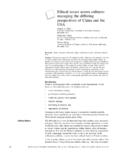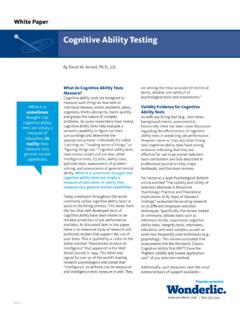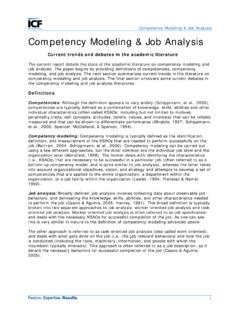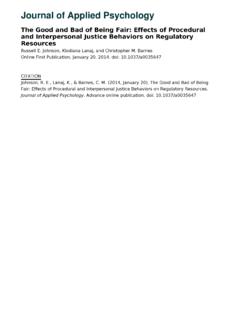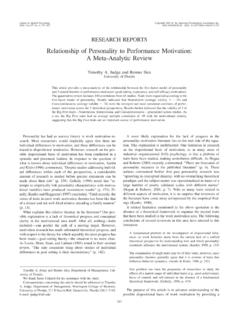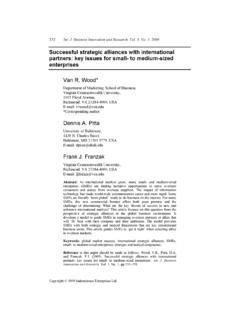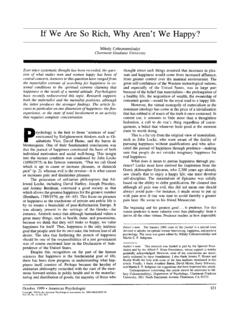Transcription of Ethical issues across cultures: managing the …
1 Ethical issues across cultures: managing the differing perspectives of China and the USA. Dennis A. Pitta Professor of Marketing, University of Baltimore, Baltimore, Maryland, USA. Hung-Gay Fung Dr Tsiang Professor of Chinese Studies, University of Missouri, St Louis, Missouri, USA. Steven Isberg Associate Professor of Finance, University of Baltimore, Baltimore, Maryland, USA. Keywords China, Consumer behaviour, Ethics, Marketing strategy, National cultures, USA. Abstract US marketers know the US standard of ethics. However, that standard can lead to Ethical conflict when Americans encounter the emerging market giant, China. As smaller US companies enter China, the potential for Ethical conflict increases. Reducing that potential requires knowledge. Knowing the nature and history of the two cultures can lead to an understanding of the foundation of their Ethical systems.
2 Ethics and the expectations within cultures affect all business transactions. It is vital for Western marketers to understand the expectations of their counterparts around the world. Understanding the cultural bases for Ethical behavior in both the USA and China can arm a marketer with knowledge needed to succeed in cross-cultural business. Implementing that knowledge with a clear series of managerial guidelines can actualize the value of that understanding. Introduction Western businesspeople often concentrate on the fundamentals. In the business and marketing sense, the fundamentals are: . sound marketing strategy;.. professional marketing research;.. world-class product development;.. effective pricing;.. motivating promotion; and . appropriate distribution. Focusing on the basics makes success in competitive markets possible. However, serious problems can materialize in business practice between the West and the emerging market giant, China.
3 Cultural factors The difficulty lies in more fundamental issues than product, price, promotion and place. With the transition from domestic-focussed operations to a true worldwide view, other factors are essential for success. One pervasive factor is culture . culture and the expectations within cultures affect all business transactions. It is vital for Western marketers to understand the expectations of their counterparts around the world. Even at the threshold of the millennium, inability to master the basic cultural factors still leads to failure. To be accurate, culture is one of the factors that affect business ethics. The Random House College Dictionary defines ethics as, ``the rules of conduct 240 JOURNAL OF CONSUMER MARKETING, VOL. 16 NO. 3 1999, pp. 240-256 # MCB UNIVERSITY PRESS, 0736-3761. recognized in respect to a particular class of human actions or a particular group, culture , etc.
4 ''. Different cultures have different rules of conduct and therein lies the issue addressed in this paper. That issue is: understanding the roots of ethics across the two cultures. Differences in systems of Primary cultural values are transmitted to a culture 's members by parenting laws and socialization, education, and religion. There are also secondary factors that affect Ethical behavior. They include differences in the systems of laws across nations, accepted human resource management systems, organizational culture , and professional cultures and codes of conduct. Our objective is not to point out which practices are Ethical and which are unethical. Our objective is to understand the differences and outline a means of managing them. What is important is that some cultures might view these practices with different levels of condemnation. Therein lies the problem for managers engaged in cross-cultural transactions.
5 How do they anticipate and manage differences in Ethical behavior rooted in differences in culture ? The following discussion concentrates on the differences in the cultures of the USA and China, in an attempt to clarify potential sources of Ethical discrepancy. Ethical behavior in different cultures For Americans, the 1980s and 1990s marked the realization of the global economy. Even ordinary consumers know more about the national origin of the products they consume. The biggest impact seems to have been on small businesses. The US Government and many states offer global business help to all businesses. As smaller firms enter the global marketplace, they encounter different Ethical frameworks than those of their domestic markets. Smaller firms may be less well-equipped to deal with the differences. This trend has highlighted the need to manage potential Ethical conflict before it becomes a problem.
6 Supporting that end, research into the ethics of international management has become a growing field (Jeurissen and van Luijk, 1998; Jackson and Artola, 1997; Honeycutt et al., 1995; Armstrong and Sweeney, 1994). Cultural conflict Unethical behavior Newspapers contain stories highlighting the domestic unethical behavior of managers. The behavior includes: . illegal campaign contributions;.. bribery;.. knowingly selling defective goods;.. hiding information; and . other troubling acts. These instances represent individual or organizational misconduct; there is an Ethical framework that is not followed. The more serious problem entails two different Ethical standards meeting in a business transaction. This situation is characterized as a cultural conflict. Even in the West, Ethical differences can lead to contrasting business practices. The Foreign Corrupt Practices Act, enacted in the USA, is the source of a glaring comparison.
7 US companies, in their worldwide operations, are forbidden to engage in activities that are illegal in the USA. As a case in point, bribery to obtain business is strictly forbidden for a US. JOURNAL OF CONSUMER MARKETING, VOL. 16 NO. 3 1999 241. company, no matter where in the world it takes place. Company officers can face jail terms and hefty fines are common. Bribery part of fabric of life In some countries, bribery is part of the fabric of life and no business can be transacted without it. Without knowing whom to pay to grease the wheels, companies face frustration and failure. If a US company resorts to bribery, it faces great pressure to hide it, including hiding it in financial statements. In contrast, other countries have a more tolerant or pragmatic view of bribery. As a case in point, at this writing, bribes are explicitly tax deductible in another Western country, Germany.
8 When considering countries that do not share a common cultural heritage, the challenges can be even greater. culture , the basis for business ethics There is common agreement that a country's culture is directly related to the Ethical behavior of its managers. The behavior is exhibited in two main ways: first, by overt actions such as public or corporate statements and actions about Ethical behavior; second, by the collection of the group of Ethical attitudes and values. One problem in dealing with culture is that it is difficult to define universally. It represents the values and patterns of thinking, feeling and acting in an identifiable group. While many nations possess the infrastructure of modern, developed civilization, culture represents how people in the civilization interact with one another. A view that may help understand culture is to look at its levels (Schein, 1985).
9 Schein (1985) proposed that culture has three levels. The most obvious concerns the works of culture , its artifacts. These are apparent and portray some of the values of the culture . Public works, works of art, museums, hospitals and universities can reveal the value that the culture places on the arts and sciences. The Coliseum, in ancient Rome, and its purpose in entertaining the public revealed how Romans valued individual human life. Rules of conduct A deeper and less obvious level comprises those things which individuals hold dear and which guide their behavior. They serve as rules of conduct and can be important guidelines for how individuals should or ought to behave. The Japanese elevation of politeness in behavior may reflect the limited physical space in the island nation. However, politeness to others is clearly how the Japanese should behave toward one another.
10 Violations of the norm cause others surprise and anger and sometimes lead to sanctions against the offender. The third and hidden level represents values, and specifically represents the assumptions we use to perceive and deal with reality. For example, some cultures perceive people as essentially good while others tend to take a more pessimistic view. It is difficult to separate the lower two levels since attitudes and values tend to overlap. However, they form the underpinnings of individual and business interactions. Dimensions of culture The goal of identifying a nation's value assumptions can be achieved by studying the dimensions of its culture . Kluckholn and Strodtbeck (1961). compared a number of cultures across six dimensions, which have been studied by scholars in non-business fields for many years. The six dimensions can be articulated as the following six questions: 242 JOURNAL OF CONSUMER MARKETING, VOL.
